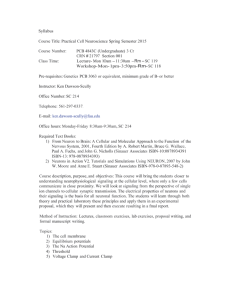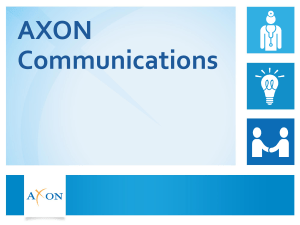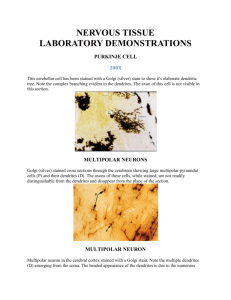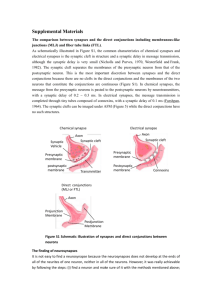Learning and the Brain
advertisement
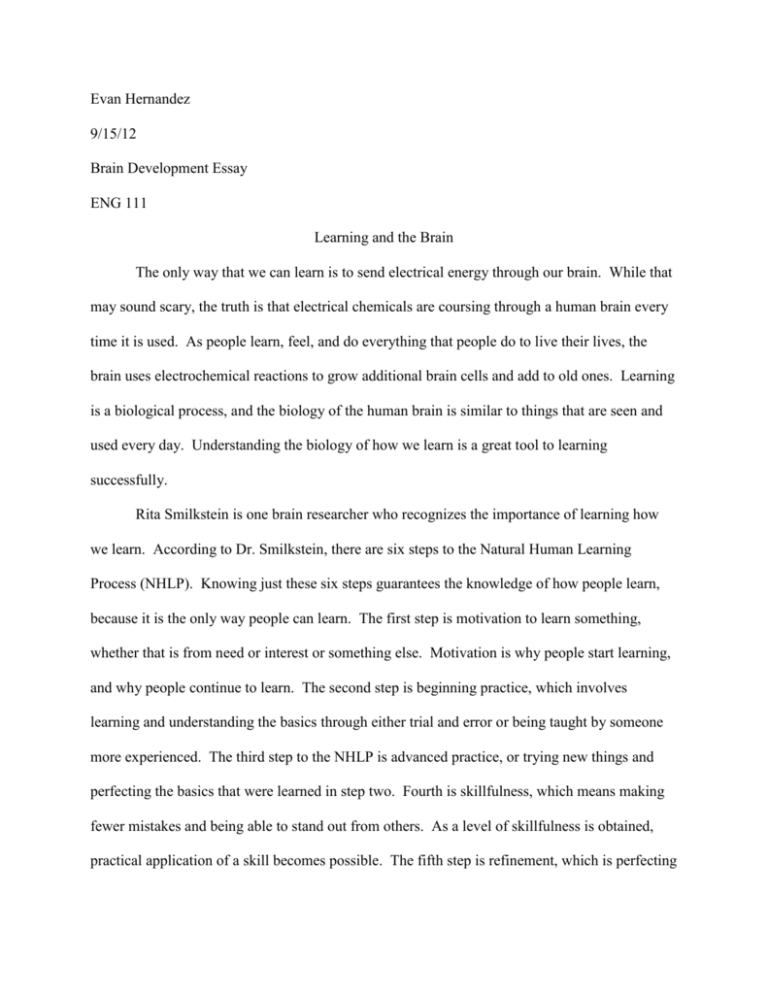
Evan Hernandez 9/15/12 Brain Development Essay ENG 111 Learning and the Brain The only way that we can learn is to send electrical energy through our brain. While that may sound scary, the truth is that electrical chemicals are coursing through a human brain every time it is used. As people learn, feel, and do everything that people do to live their lives, the brain uses electrochemical reactions to grow additional brain cells and add to old ones. Learning is a biological process, and the biology of the human brain is similar to things that are seen and used every day. Understanding the biology of how we learn is a great tool to learning successfully. Rita Smilkstein is one brain researcher who recognizes the importance of learning how we learn. According to Dr. Smilkstein, there are six steps to the Natural Human Learning Process (NHLP). Knowing just these six steps guarantees the knowledge of how people learn, because it is the only way people can learn. The first step is motivation to learn something, whether that is from need or interest or something else. Motivation is why people start learning, and why people continue to learn. The second step is beginning practice, which involves learning and understanding the basics through either trial and error or being taught by someone more experienced. The third step to the NHLP is advanced practice, or trying new things and perfecting the basics that were learned in step two. Fourth is skillfulness, which means making fewer mistakes and being able to stand out from others. As a level of skillfulness is obtained, practical application of a skill becomes possible. The fifth step is refinement, which is perfecting what is already known through continued practice and application as growth carries on towards the sixth step. Finally, the sixth step is mastery, which is standing out among most others and being able to teach others (Smilkstein 49). One skill that I have learned, through the stages of the NHLP, is being able to flip a butterfly knife. My motivation for learning is that I thought that it was a skill that looked cool, so I wanted to learn it. To begin practice, I looked at diagrams and watched YouTube videos in order to learn the basic opening technique. For my advanced practice, a stage in which a still am currently in, I perfected the basic opening and learned one new trick which I am still perfecting. Skillfulness would require me to learn more flips, refinement would mean perfecting those tricks, and mastery would involve me making my own YouTube videos to show others the skill. Knowing how learning works will definitely help me achieve mastery in this skill. A person learns as his or her brain develops on a cellular level. Brains are made of cells called neurons, which develop like trees, look like trees, and have parts similar to trees. Trees start with a seed, and the parts of a neuron sprout from the soma. The axon is a fiber that comes off of the soma that provides structural support for the cell, resembling a tree trunk. Axon terminal bulbs branch off from the axon, resembling roots, and they emit neurotransmitters allowing brain growth, similar to the way that roots absorb nutrients necessary for tree growth. The myelin sheath is a membrane which covers and protects the axon, like the bark on a tree covers and protects the bark. Finally, dendrites branch off of the end of the axon opposite the axon terminal bulbs, which resemble branches. A biologist’s definition of learning would be growing dendrites, and people grow dendrites as a result of synaptic firing (Smilkstein 50-60). Synaptic firing is similar to how spark plugs fire. Spark plugs require a conductor to conduct electrical energy, just like axons conduct the electrochemical information needed for synapses to fire. A neuron’s equivalent of the electrical charge in spark plug firing is an electrical chemical transmission through the axon. The way neurons line up with their axon terminal bulbs close together, but leaving a gap called synapses, is similar to the way that there is a gap in spark plugs for the electricity to cross. Fuel is needed for spark plugs to fire, and neurotransmitters called endorphins are the “fuel” for synaptic firing. Cars go because of spark plug firing, and dendrites grow from synaptic firing. Just like there are certain things that improve or stop spark plugs from working, emotions can help or hinder synaptic firing. Emotions can greatly affect the ability one has to learn at a given time. When people feel anxious, unconfident, or have other negative emotions, they have a harder time learning because certain chemicals (norepinephrine) flow through the synapses that shut down the synaptic firing process. When a person is in a good mood, chemicals of a different type (endorphins) flow through the synapsis, which enables synaptic firing. This is why we freeze up if we are nervous and why we learn things we enjoy faster than things we don’t. Emotions have affected my learning for better and for worse before. One time in high school, I had to memorize a Bible verse to recite from memory in front of the entire class. While I had to memorize verses previously in that class, the quizzes were always written, not oral. While I was just as prepared for the oral quiz as I had been for the written quizzes in the past, this time when I went to take the quiz (i.e., stood in front of the class) I couldn’t remember even the first word. I was so nervous, that norepinephrine was flowing through my neurons instead of endorphins, making my synapses shut down. On the flip side of that metaphorical coin, I recently had a friend come to my house and he saw my poster with the phrase “John 3: 16” on it. He asked what that meant because he had seen it many times before and, because I was in a calm situation, I was able to recite the verse from memory on the spot. Learning is a biological process, and knowing how learning happens is a great skill for college students. Knowing that stress and anxiety impacts memory negatively means that I know what to do when I feel that way. It is better for me to take a few seconds before an exam to calm myself than freaking out for minutes on an easy question. It helps me to know when it is a good time to learn too. After all, will I really remember what I am studying in a waiting room when half of my mind is focused on what the doctor might say? Knowing how learning works on a biological level gives me better control over myself. Works Cited Smilkstein, Rita. We're Born to Learn: Using the Brain's Natural Learning Process to Create Today’s Curriculum. Thousand Oaks, Cal.: Corwin, 2003.
